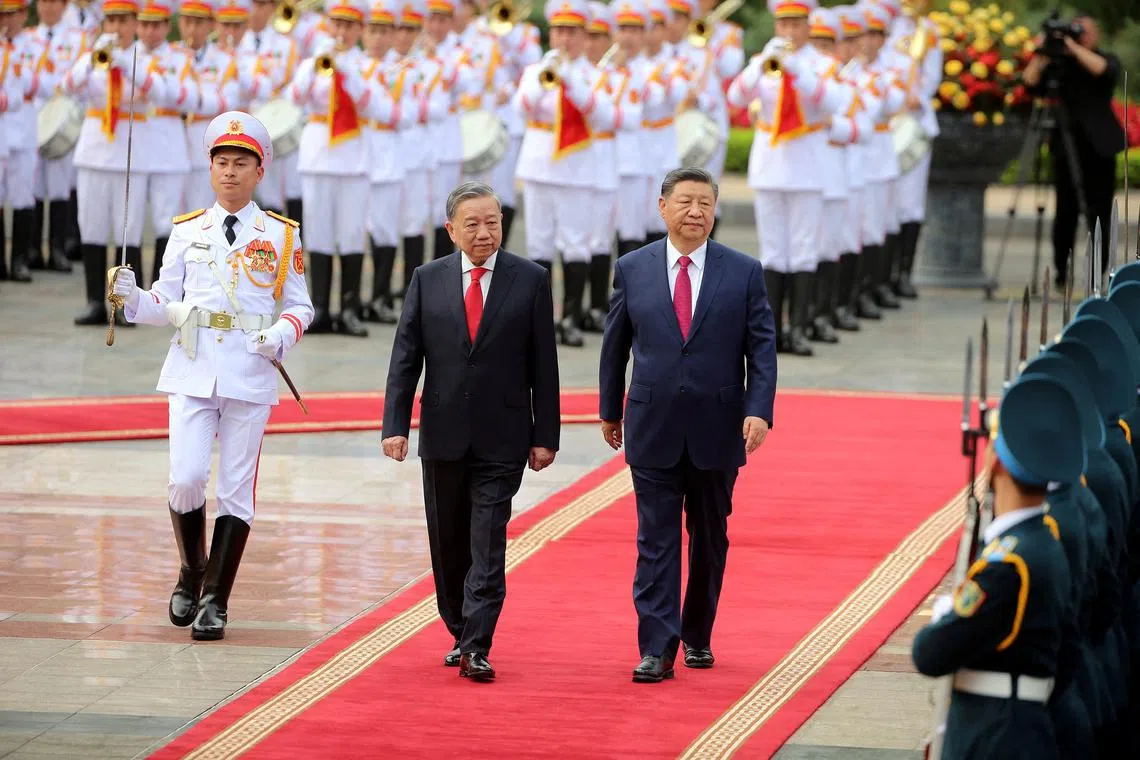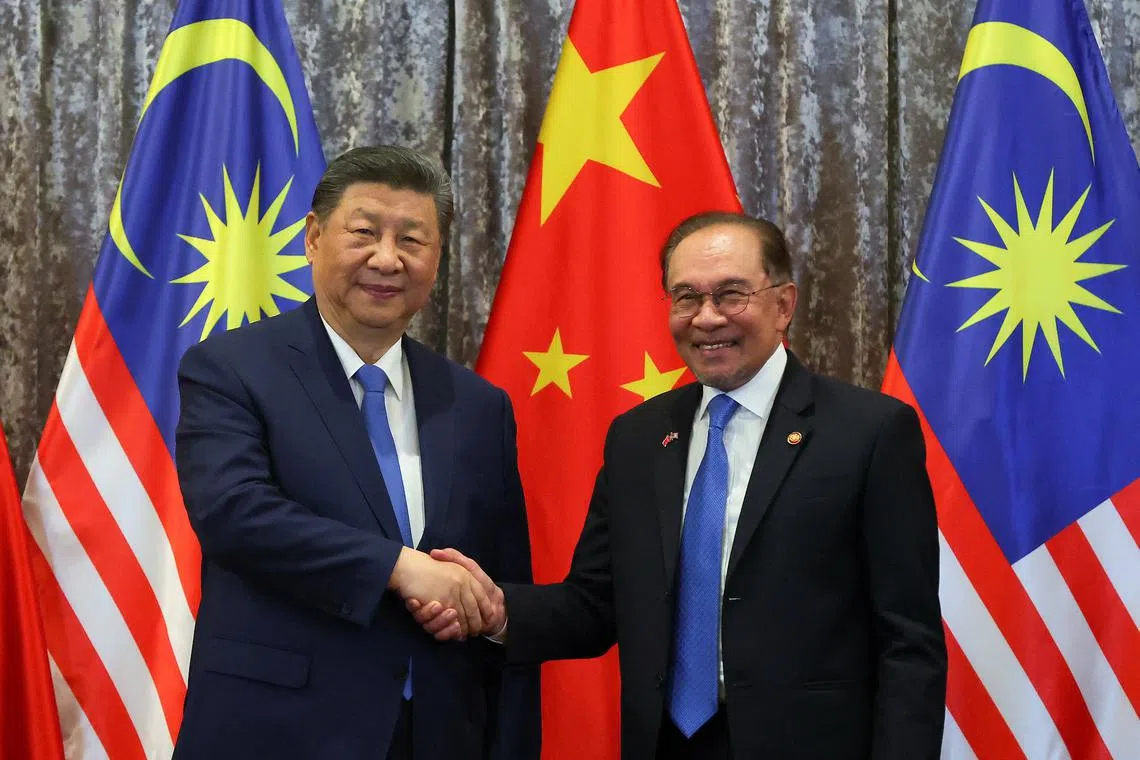News analysis
Xi plays long-term game of keeping South-east Asia onside during his tour of region
Sign up now: Get insights on the biggest stories in Malaysia

Chinese President Xi Jinping meeting Cambodian PM Hun Manet in Phnom Penh on April 17.
PHOTO: REUTERS
Follow topic:
BANGKOK – While Chinese President Xi Jinping’s whistle-stop tour of three South-east Asian nations has inevitably been viewed mostly through the prism of the immediate global ructions wrought by the Trump administration’s trade tariffs, Beijing would argue its long-term game in the region is paying off.
Mr Xi whizzed through the capitals of Vietnam, Malaysia and Cambodia in five days from April 14 to 18, during which he signed many deals designed to deepen China’s economic ties with these nations.
He also sought to convey the message that the region should band together to resist what he said was the US’ unilateralism and protectionism under President Donald Trump – basically to win the region over to Beijing’s side in its rivalry with Washington, now manifested in the tariff war unleashed by Mr Trump.
China has been slapped with a 145 per cent tariff on its exports to the US.
But South-east Asian countries are also among the hardest hit globally by the Trump administration’s so-called reciprocal tariffs announced on April 2.
While countries in the region were welcoming of the economic deals, Mr Xi’s message of solidarity was received with varying enthusiasm.
During his first stop in Hanoi, the two sides signed 45 deals, among which Vietnam’s top leader, Mr To Lam, emphasised the building of three railway lines as “the highest priority”
They include a US$8.4 billion (S$11 billion) cross-border railway crossing the breadth of northern Vietnam and connecting China’s landlocked Yunnan province to Haiphong port, via Hanoi.
China had proposed the project from as early as 2017, but Vietnam had demurred, displaying its funding worries, security concerns and a reluctance to sign up to Mr Xi’s signature Belt and Road Initiative, all underpinned by Hanoi’s historical distrust of Beijing.
Now, a feasibility study will be fast-tracked for construction to begin by the end of 2025.
“In Vietnam foreign policy, China still occupies the foremost priority, and maintaining a constructive relationship with China is still the prerequisite of the strategic stability that Hanoi is seeking amid a lot of seismic changes brought on by the second Trump administration,” said Ms Hoang Thi Ha, co-coordinator of the regional strategic and political studies programme at the ISEAS – Yusof Ishak Institute.
“A lot of attention was given to the intense scrutiny and pressure from the US, and Vietnam’s willingness to appease Washington on the trade front. This has really taken away from the real significance of this visit,” she added.

Vietnam’s top leader, Mr To Lam, and Chinese President Xi Jinping reviewing an honour guard at the Presidential Palace in Hanoi on April 14.
PHOTO: REUTERS
Over in Kuala Lumpur, Mr Xi’s second stop, Malaysian Prime Minister Anwar Ibrahim declared that China was a “rational, strong and reliable partner”
“What we are witnessing today is not an honest reckoning with the imperfections of globalisation, but a retreat into economic tribalism. Market access is being weaponised. What was once a multilateral covenant for shared growth now buckles under the weight of arbitrary disruption and unilateral whim,” Datuk Seri Anwar added.
Vietnam, however, used a more reserved tone than Malaysia on the subject of the US’ unilateralism and protectionism.
It released a joint statement with China saying that both countries would “pay attention” to trade and investment restrictions while pledging to “oppose unilateralism”.
This reflects the precarious situation Vietnam finds itself in with the US, which accounts for 30 per cent of its exports, and its apparent desire to avoid making any public comments that may upset Mr Trump as it seeks to negotiate lower tariffs with Washington.
Mr Anwar’s full-throated support of Mr Xi raised some eyebrows while also presenting an easy diplomatic win for Beijing.

Mr Xi with Malaysian PM Anwar Ibrahim in Kuala Lumpur on April 16.
PHOTO: REUTERS
Ultimately, however, all the world leaders meeting Mr Xi behaved predictably in a throwback to the staid choreography of traditional diplomacy: stage-managed photo opportunities, exchanging bromides and dozens of memorandums of understanding, and leaving any pointed exchanges behind closed doors.
Of Mr Xi’s visit to Vietnam, Mr Trump had this to say: “I don’t blame China. I don’t blame Vietnam. I see they’re meeting today.”
“Isn’t that wonderful? And it’s a lovely meeting. They’re meeting, like, trying to figure out, ‘How do we screw the United States of America?’” he told reporters in the Oval Office on April 14.
In Mr Xi’s last stop in Cambodia, both sides espoused their “ironclad” friendship and exchanged 37 deals, deepening economic ties.
China, Cambodia’s largest creditor, has invested billions of dollars in major infrastructure projects such as roads and airports, as well as a major special economic zone.
Phnom Penh has been at pains to say that China would help fund the Funan Techo Canal,
China, however, had previously made no public financial commitment to the project, previously stretching 180km and estimated to cost US$1.7 billion (S$2.23 billion), or some 4 per cent of Cambodia’s annual gross domestic product, and wrote no new loans to Phnom Penh in 2024.
The project will now be scaled back to 151.6km, and is now valued at US$1.16 billion, the Cambodian government said in a statement on April 18. It will be financed through a public-private partnership with Chinese investors holding 49 per cent.
“China supports Cambodia in building the Funan Techo Integrated Water Conservancy Project in accordance with the principles of feasibility and sustainability,” the two countries said in a joint statement.
Philip Wen is regional correspondent at The Straits Times, covering South-east Asia from his base in Bangkok.


